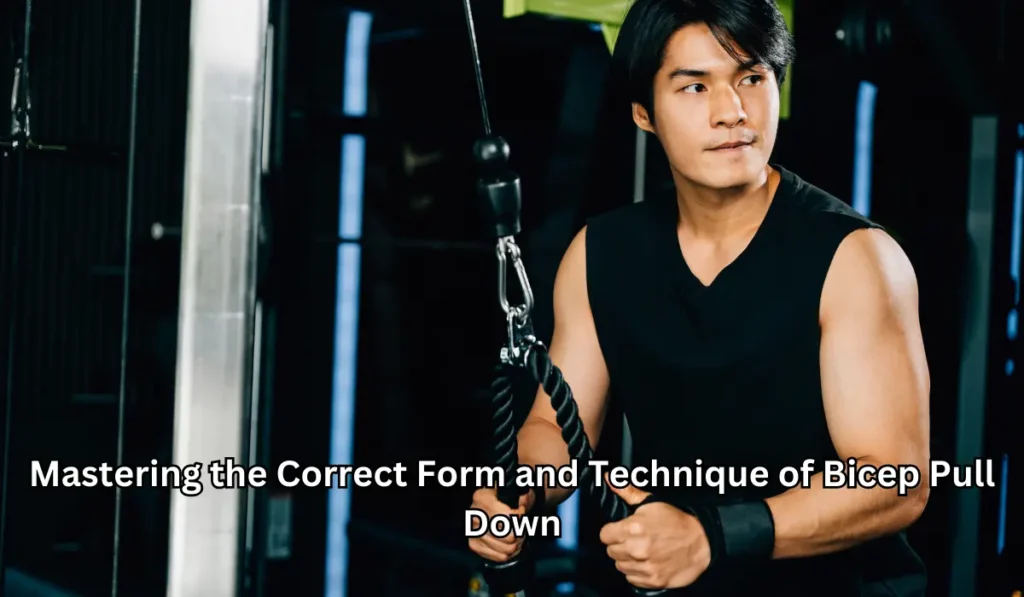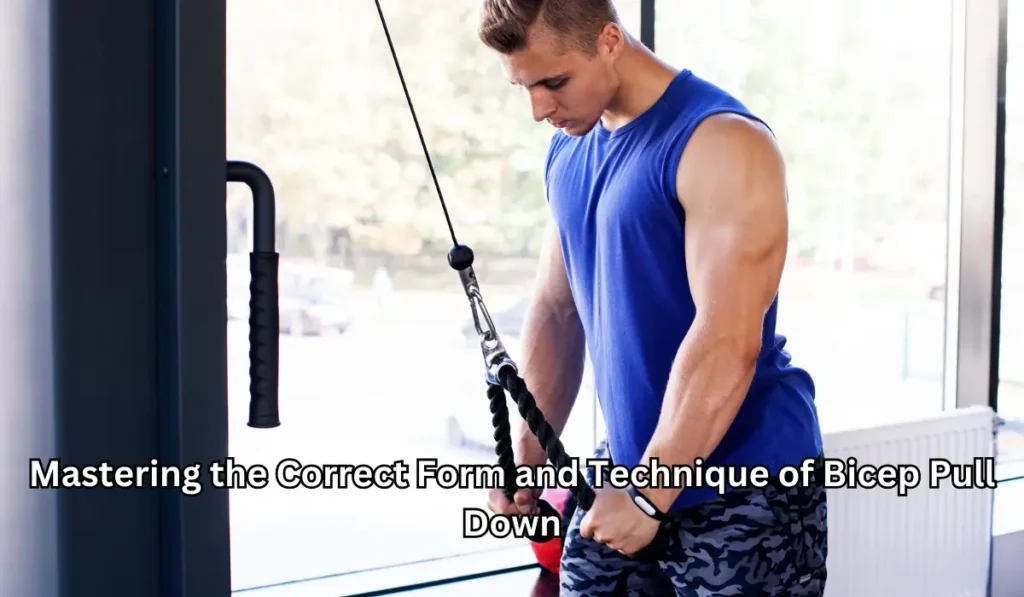
Mastering the Correct Form and Technique of Bicep Pull Down
The bicep muscle is one of the most popular muscles to train, and there are many exercises to target it. One of the most effective is the cable pull-down exercise, which involves using a cable machine to pull a weight down toward your body while keeping your arms straight. This exercise can be done in a variety of ways, but mastering the correct form is essential for maximizing results and avoiding injury.
In this blog post, we will explore the correct form and technique for the cable pull-down exercise, as well as some common mistakes to avoid. We’ll discuss the importance of proper grip, elbow positioning, and breathing techniques to get the most out of each rep. We’ll also look at different variations of the exercise, such as using a wide or narrow grip, and how these variations can target different areas of the bicep muscle.
Whether you’re a beginner or a seasoned gym-goer, mastering the cable pull-down exercise can take your bicep training to the next level. So, grab your cable machine and let’s get started on mastering the correct form for maximum results!
Understanding the Cable Pull-Down Exercise
The cable pull-down exercise is a weight training exercise that targets the bicep muscles in the arms. It is performed using a cable machine, which consists of a weight stack connected to a cable and handle attachment. To perform the exercise, the cable is attached to a high pulley and the handle is grasped with an underhand grip.
The exercise is performed by pulling the handle down towards the body while keeping the arms straight, and then slowly releasing the weight back up to the starting position. The movement should be controlled and smooth, with the focus on using the bicep muscles to pull the weight down, rather than relying on momentum or other muscle groups.
The cable pull-down exercise can be performed in a variety of ways, including using different grip widths, hand positions, and angles. These variations can target different areas of the bicep muscle and provide a more comprehensive workout.
Equipment Needed for Bicep Pull Down
To perform the cable pull-down exercise, you will need access to a cable machine, which is typically found in most gyms. The cable machine consists of a weight stack attached to a cable and handle attachment. You may also need a weightlifting belt for additional support, particularly when lifting heavier weights.
When setting up the cable machine for the exercise, make sure the weight stack is set to an appropriate weight for your fitness level and goals. The handle attachment should be attached to the cable and adjusted to the appropriate height for your body.
It is also important to make sure the cable machine is stable and secure before starting the exercise. Check the equipment for any signs of wear or damage, and make sure it is properly maintained and lubricated for smooth movement.
Read about Technique of Bicep Pull Down

Correct Form and Technique
Proper form and technique are essential when performing the bicep pull down exercise to avoid injury and maximize results. Here are the steps to follow for correct form and technique:
- Stand facing the cable machine with your feet shoulder-width apart and your knees slightly bent. Grasp the handle with an underhand grip, making sure your hands are shoulder-width apart.
- Keeping your back straight, engage your core muscles and maintain a slight bend in your elbows throughout the exercise.
- Pull the handle down towards your thighs, using your biceps to control the movement. Exhale as you pull the handle down and focus on squeezing your biceps at the bottom of the movement.
- Slowly release the weight back up to the starting position, inhaling as you do so. Keep your arms straight but do not lock your elbows.
- Repeat for the desired number of reps, making sure to maintain proper form and technique throughout.
It is important to avoid using momentum or other muscle groups to lift the weight, as this can lead to injury and minimize the effectiveness of the exercise. Make sure to focus on using your biceps to control the movement and keep the motion smooth and controlled.
Remember to start with a lighter weight and focus on proper form and technique before increasing the weight. This will help to prevent injury and ensure maximum muscle activation.
Step-by-Step Guide
Here is a step-by-step guide on how to perform the bicep pull down exercise with proper form and technique:
- Adjust the cable machine: Start by adjusting the cable machine so that the handle attachment is attached to the high pulley. Adjust the weight stack to an appropriate weight for your fitness level and goals.
- Stand facing the machine: Stand facing the cable machine with your feet shoulder-width apart and your knees slightly bent.
- Grasp the handle: Grasp the handle with an underhand grip, making sure your hands are shoulder-width apart.
- Position your body: Keeping your back straight, engage your core muscles and maintain a slight bend in your elbows throughout the exercise.
- Pull the handle down: Pull the handle down towards your thighs, using your biceps to control the movement. Exhale as you pull the handle down and focus on squeezing your biceps at the bottom of the movement.
- Release the weight: Slowly release the weight back up to the starting position, inhaling as you do so. Keep your arms straight but do not lock your elbows.
- Repeat for desired reps: Repeat for the desired number of reps, making sure to maintain proper form and technique throughout.
Tips:
- Avoid using momentum or other muscle groups to lift the weight, as this can lead to injury and minimize the effectiveness of the exercise.
- Focus on using your biceps to control the movement and keep the motion smooth and controlled.
- Start with a lighter weight and focus on proper form and technique before increasing the weight. This will help to prevent injury and ensure maximum muscle activation.
- Incorporate different variations of the exercise, such as using a wide or narrow grip, to target different areas of the bicep muscle.
Variations of the Cable Pull-Down Exercise
There are several variations of the bicep pull down exercise that can help target different areas of the bicep muscle and provide a more comprehensive workout. Here are some variations to consider:
- Wide grip cable pull-downs: Using a wider grip on the handle attachment can help target the outer bicep muscles. To perform this variation, grasp the handle with a wider-than-shoulder-width grip and pull it down towards your thighs.
- Narrow grip cable pull-downs: Using a narrow grip on the handle attachment can help target the inner bicep muscles. To perform this variation, grasp the handle with a grip that is closer than shoulder-width and pull it down towards your thighs.
- Reverse grip cable pull-downs: Using a reverse grip on the handle attachment can help target the brachialis muscle, which is located underneath the biceps. To perform this variation, grasp the handle with an overhand grip and pull it down towards your thighs.
- Single-arm cable pull-downs: Performing the exercise with one arm at a time can help to isolate the bicep muscles and provide a more intense workout. To perform this variation, grasp the handle with one hand and pull it down towards your thigh, keeping your elbow close to your body.
- Cable hammer curls: Hammer curls are another effective exercise for targeting the bicep muscles. To perform this variation, grasp the handle with a neutral grip (palms facing each other) and curl the weight up towards your shoulder, keeping your elbows close to your body.
Incorporating these variations into your bicep workout routine can help target different areas of the muscle and prevent plateaus in your progress. As always, it is important to use proper form and technique when performing any exercise to avoid injury and maximize results.
Read about Hammer Strength Hack Squat
Common Mistakes to Avoid
When performing the cable pull-down exercise, there are several common mistakes that should be avoided to prevent injury and maximize results. Here are some mistakes to watch out for:
- Using too much weight: Using too much weight can lead to poor form and technique, and increase the risk of injury. Start with a lighter weight and focus on proper form and technique before increasing the weight.
- Using momentum to lift the weight: Using momentum to lift the weight can minimize the effectiveness of the exercise and increase the risk of injury. Focus on using your biceps to control the movement and keep the motion smooth and controlled.
- Locking your elbows: Locking your elbows at the bottom of the movement can lead to injury and minimize the effectiveness of the exercise. Keep your arms straight but maintain a slight bend in your elbows throughout the exercise.
- Leaning back: Leaning back or arching your back can put unnecessary strain on your lower back and increase the risk of injury. Keep your back straight and engage your core muscles throughout the exercise.
- Using improper grip or hand positioning: Using an improper grip or hand positioning can lead to poor form and technique, and increase the risk of injury. Use a grip that is comfortable for your hands and maintain proper hand and elbow positioning throughout the exercise.
By avoiding these common mistakes and focusing on proper form and technique, you can maximize the effectiveness of the cable pull-down exercise and prevent injury. Remember to start with a lighter weight and gradually increase the weight as you become more comfortable with the exercise.

Conclusion
The bicep pull down exercise is an effective way to target the bicep muscles and improve upper body strength. By mastering the correct form and technique, you can maximize muscle activation and prevent injury. Incorporating different variations of the exercise, such as using a wide or narrow grip, can help to target different areas of the bicep muscle and provide a more comprehensive workout.
It is important to avoid common mistakes when performing the exercise, such as using too much weight or using momentum to lift the weight. By starting with a lighter weight and focusing on proper form and technique, you can prevent injury and maximize results.
Remember to listen to your body and adjust the exercise as needed to avoid pain or discomfort. By incorporating the cable pull-down exercise into your regular workout routine and focusing on proper form and technique, you can improve your bicep strength and achieve your fitness goals.